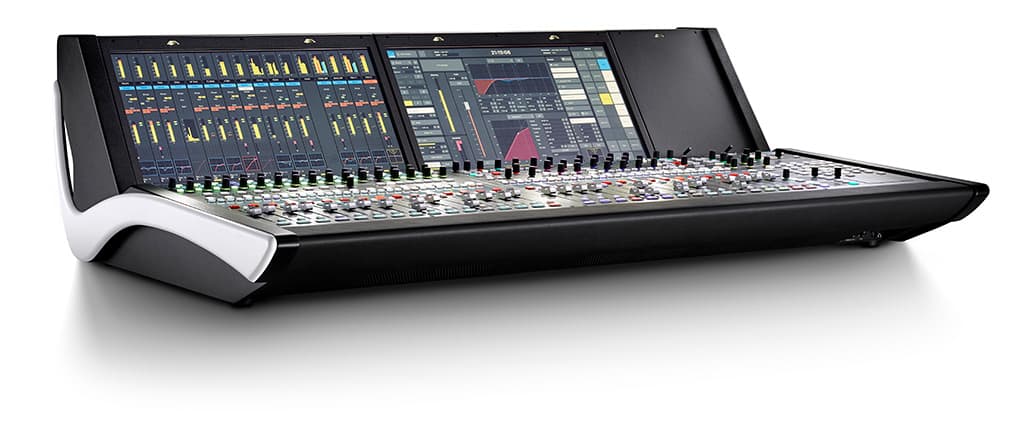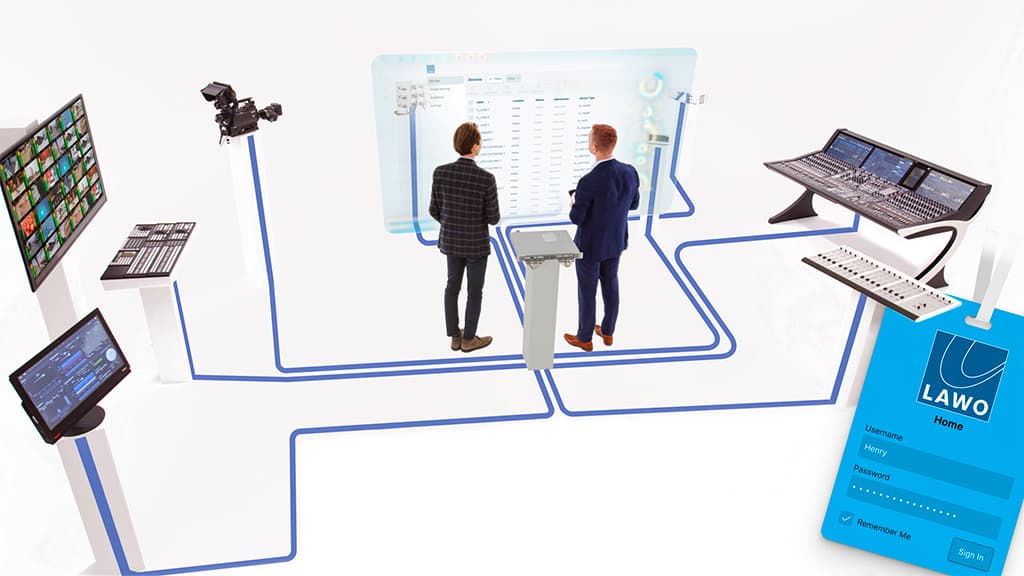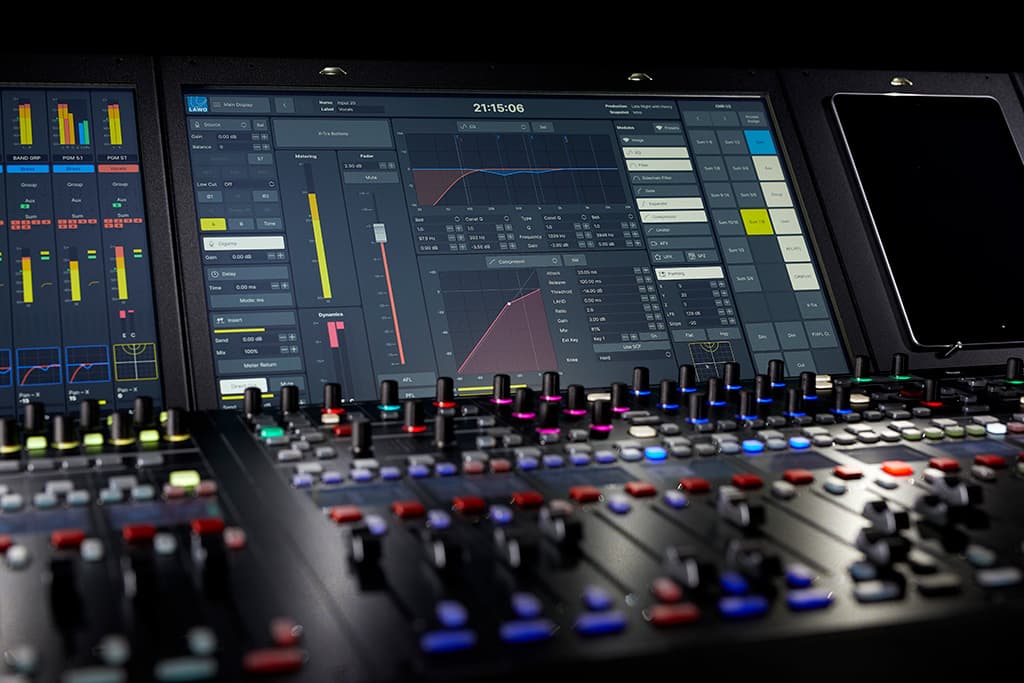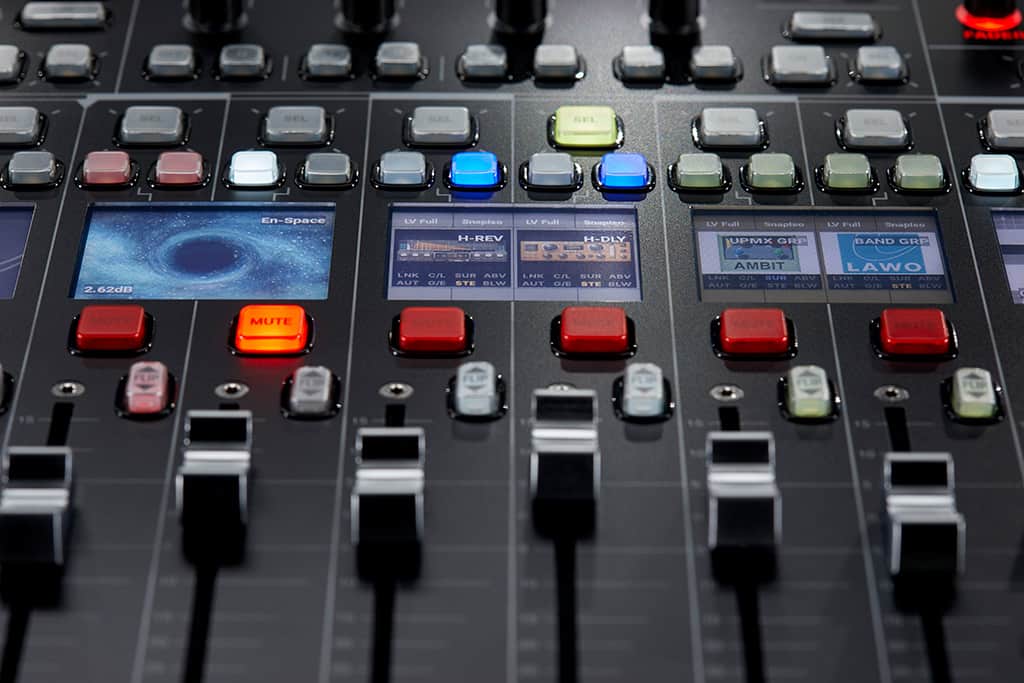
Review: Lawo mc²36
Lawo’s mc² family is now joined by the all-in-one mc²36. Could this be the beginning of a brave new ST2110 world?
Tech Overview: Christopher Holder
You have my permission to bail right now. If you were expecting to read a regular product review, I apologise in advance. But to understand Lawo’s mc²36 you need to wrap your head around a new way of working; a different paradigm.
That said, it’s not a million miles from when Dante first landed in Yamaha’s digital mixing consoles back in 2012.
Prior to that, MADI was king when it came to moving multiple channels of digital audio (and is still a very valid option if point-to-point is all that’s required). Okay, prior to that, Cobranet was a ‘thing’ but not so much in production. And prior to that, digital consoles used traditional analogue snakes and splitters, retaining the conversion stage in the mixer.
Yamaha helped Dante go mainstream, and it was an eyeopener for those working with digital audio — uncompressed audio over a standard IP network brought about an unprecedented level of versatility for moving multi-channel audio around.
Dante is now, arguably, an even bigger deal in the world of installed audio than it is in production. For large (even multi-campus) installations, Dante Domain Manager makes the job of an AV/IT administrator much easier, albeit with a significant pricetag.
ENTER AES67
In the background, while Dante became the defacto digital audio standard, others lobbied for an open IP audio standard or at least a way of allowing different standards like Dante, Q-LAN and Ravenna to talk to each other. The Audio Engineering Society developed the AES67 interoperability standard for IP-based audio networking products. AES67 isn’t trying to compete with Dante or Q-Sys’s Q-LAN, so much, as being a common language for various uncompressed PCM audio network protocols to speak to each other.
SMPTE has also been developing its own open standard for network video and audio. It’s called ST2110 and is now a big deal, especially in the world of broadcast. As broadcasters upgrade their facilities and move away from point-to-point SDI signal transport to IP networks, ST2110 has stepped into the breach.
LAYER 3 SPREE
ST2110 takes full advantage of the flexibility of being a Layer 3 network standard. It moves between subnets without a hitch and the ease with which it multicasts (one input to many outputs without any additional load on the stream’s bandwidth) makes particular sense to the broadcast world — it really is a case of audio going from ‘anywhere to anyone’ without question.
But one of the reasons why people love Dante so much is how easy it is to use. Dante does all the administrative hard work for you. You don’t need to understand IP networks to operate Dante-based gear (but it helps if you’re a system designer, obviously).
ST2110 currently needs IP network knowledge to use.
MORE INFO
Lawo mc²36
Digital Audio Mix System
CONTACT
Professional Audio & Television: (02) 9476 1272 or www.proaudiotv.com.au
SUMMARY
A few years ago, Lawo completely retooled to go all-in on the ST2110 universe. This all-in-one console will join its bigger siblings in many Lawo-based production spaces. Investing in the mc²36 as your first Lawo mixing console will require a SMPTE ST2110 retooling of your own. Depending on the size and demands on your facility, it may be the best move you’ve ever made.

LAWO & ST2110
A few years back, Lawo saw the future and it was ST2110. Lawo isn’t in the business of selling mixing consoles so much as it is in the supply of networked audio systems, mostly for broadcasters, where mixing consoles are the most visible piece. These systems are almost infinitely customisable, configurable, extremely powerful and pricey.
It makes a lot of sense for Lawo-managed audio to exist in the same ST2110 world as the broadcaster’s video (the ST2110 standards for video are widely adopted). It also makes huge sense to use an open standard that can be endlessly scaleable and flexible, and ensuring Lawo’s destiny is entirely in their own hands and not in Audinate’s, for example.
But it would take a power of work for Lawo to develop a whole new control and management software overlay so that audio engineers can work with Lawo hardware and not just IT engineers.
That software is called Home.

HEADING HOME
Home allows operators to easily discover and configure ST2110 devices on their network. As an audio operator, it might be a 2110 stagebox. That stagebox might be sitting next to you or sitting across the country. Home renders much of the IP networking invisible to the operator.
Lawo’s mc² series of mixing consoles are sophisticated control surfaces. The audio ins and outs, and the DSP aren’t ‘in’ the console, they can be and are mostly somewhere else. I know that’s true of some live sound mixing consoles, to a point, and often a monitor console will share the stagebox with the FOH console. But in a ST2110 world that stagebox is just as easily addressable by that venue’s broadcast studio on the other side of the building, or an OB truck in the carpark, or a remote operator in their living room, interstate.
CASE FOR LAWO
To buy a Lawo console is to buy into the ST2110 ecosystem. Can the mc²36 live in a MADI or Dante world? Yes, but I’d argue that it’s too big an investment to be pushing a square 2110 ‘peg’ into a round Dante ‘hole’.
Apart from broadcasters, such as NEP in Australia and many others worldwide, who is going ‘all in’ with ST2110? No one, is the short answer. But that won’t be true for much longer.
There are three main reasons why larger venues and organisations will be thinking about ST2110 for their audio transport.
- Because they need to upgrade their video transport: ST2110 is becoming a preferred standard for network video and doing the same for audio makes a lot of sense.
- Multi-campus flexibility: Large religious organisations, exhibition centres and education providers, for example, will find the ease in which ST2110 audio moves between subnets and geographical disconnection a real asset.
- Remote production: the pandemic has demonstrated just how important remote production can be to keep the show ‘on the road’. Post-Covid, many venues will want to bake in a remote production backstop if key staff become otherwise unavailable. ST2110 makes remote mixing easy to wrangle.
Finally, an observation: more and more institutions are becoming broadcasters. By which I mean, they’re dealing with media. Video, audio, comms and other content are becoming decreasingly siloed. This is the world that the SMPTE ST2110 IP networking standard is inheriting.
Admittedly, the number of ST2110 edge devices are currently rare as hen’s teeth. Lawo is one of the trailblazers, while Merging Technologies and Direct Out are also releasing some hardware. But if you’re a larger organisation that sees the many advantages of media being available unhindered anywhere in your orbit then you wouldn’t be doing your due diligence without examining the case for a ST2110-based media ecosystem. Chances are, Lawo will be sitting at the top of that particular dossier.
What is AES67
AES67 is a standard defined by the Audio Engineering Society to enable high-performance audio-over-IP streaming interoperability between various IP-based audio networking products currently available. It is not a new technology; rather, it is an interoperability mode that enables bridging of various IP-based audio networking technologies. (AIMS – Alliance for IP Media Solutions)
What is SMPTE ST2110
SMPTE ST 2110 ‘Professional Media Over Managed IP Network’ is a suite of standards specifying the carriage, synchronisation, and description of separate elementary essence streams over professional internet protocol (IP) networks in real-time for the purposes of live production, playout, and other professional media applications. (AIMS – Alliance for IP Media Solutions)

CONSOLE VITALS
The mc²36 is Lawo’s baby. The mc²56 and mc²96 are the original, larger siblings in the mc² range. Chief among the mc²36’s ‘compact’ credentials, is the onboard I/O. The others are control surfaces designed to interface with remote I/O.
That said, the mc²36 shares just about every other aspect of the the mc² DNA. The control surface has fewer knobs and buttons, as you’d expect, but anyone familiar with mc² consoles will hop straight on.
The MCX software is the same, the A_UHD DSP brain is the same, the processing, the preamps, the metering etc is all the same.
There are three mc²36 frame sizes: 16, 32 and 48 faders (the 48-fader model, with dual-fader section, actually has the same footprint as the 32-fader model). The 16-fader version is only 833mm wide, making it well suited to OB vans or other tight situations with minimum elbow room. The 48-fader frame is still a comparatively slender 1275mm.
Regardless of the physical I/O on the back of the mc²36 a total of 160 inputs are possible. Overall, 256 DSP channels (160 inputs and 96 summing buses) are available. The term ‘DSP channel’ describes any strip on the console that’s ‘dealing’ with signal in some way, in or out, group, VCA, bus etc.
Like most professional digital consoles, the mc²36 is highly customisable, whether that’s where you position your ins and outs on the console, the order in which you apply your processing, and many other aspects. It feels like there’s always at least two way of skinning the cat on this console.
If you talk to die-hard Lawo operators, they’ll inevitably stress the mc²’s versatility, which is absolutely crucial in broadcast operations, where producers will inevitably throw curveballs at you — ‘head of catering wants to hear the pit lane commentator, can you make that happen?’… I’m only half joking.
NIFTY FEATURES
Speaking of Lawo’s broadcast industry credentials, it does inform some of the more innovative features at times.
I love the Listen Sense function, for example, which allows an offline modification of channel parameters like EQ or dynamics. Get things tuned-up and then go live with it, all without the audience hearing you tinker under the bonnet.
I like the remote desktop feature that allows you to use the console’s big, 21.5-inch, TFT real estate to display an external PC running, say, ProTools, Waves Soundgrid or even your laptop, so you can use the console’s trackpad to delete spam between shows.
The LiveView video channel strip labels are also something else. In addition to standard channel labelling using channel numbers, individual text labels and static pictures or icons, the mc²36 does video thumbnails. If you have 10 reporters roving the pit lane, for example, having a corresponding motion JPEG thumbnail on the channel could could save you valuable milliseconds in identifying which fader you’re throwing. The same applies to productions with multiple video replay machines.
Reveal (and Reveal in Place) is another feature that caught my eye. It enables automatic input sorting of VCAs, subgroups and auxes. When activating Reveal for a dedicated VCA/Sub/Aux fader, the console sorts all channels of that specific group at a pre-defined position, giving instant access no matter in which bank or layer the channels are originally based. For even quicker access, pressing and holding the Select button activates Reveal-in-Place. After deactivating Reveal, the console returns to its prior fader layout. This makes it possible to conveniently handle large productions without the need for 96 faders.

CONTROL PANEL
- Frames with 16, 32 and 48 faders (48-fader model with dual-fader section, same footprint as the 32-fader model)
- 6 banks each with 2 layers
- 100mm fader + 1 freely adjustable rotary encoder (mc²36-32) + channel display for each fader with sense-triggered change of module display
- TFT metering: mono, stereo or up to 7.1 including bus assignment, gain reduction for dynamics, AfV status, VCA assignment, Mix-Minus, Signal Patching, Meter selection, Automix state
- GUI page output, e.g. metering, on an external monitor
- 10 Central user buttons, 2 Central user encoders, 1 talkback button and 2 fader user buttons with 8 functions each

SIGNAL PROCESSING
- 40-bit floating point
- 256 DSP channels (160 inputs and 96 summing buses)
- Up to 160 inputs with A/B input, up to 96 aux buses, up to 96 groups, up to 96 main sums, 32 Automix groups
- Up to 32 surround channels, 128 VCA groups with metering, 256 GP channels
- Loudness Metering according to EBU R128 and ATSC A/85, momentary or short term in every channel, integrated measurement on sum channels with display of integrated LUFS value in headline
- Modules: INMIX with MS decoder, digital amp, 2-band fully parametric filter, 4-band fully parametric EQ, 2-band fully parametric side chain filter, insert, delay up to 1800ms – switchable units: meters, milliseconds, frames,
- 4 independent dynamic modules: expander, gate, compressor (incl. parallel compression), limiter, image, meter, direct out
- 32 Automix groups available for mono/stereo/surround channels with unlimited contributing channels each
















I am interested in the retail price of this brand/range of digital audio mixers?
Give the guys at Professional Audio & TV a shout Tony.